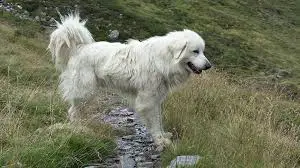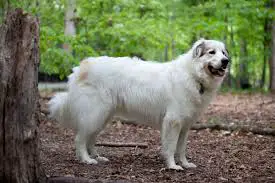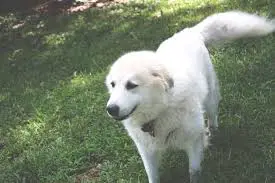German Shepherd Great Pyrenees Mix
The German Shepherd and Great Pyrenees Mix is a mixed Dog Breed between the German Shepherd and the Great Pyrenees. This is going to be a large dog that will make a good watch dog. They will also do well being around livestock, especially sheep and goats.
While we really recommend that you acquire one through a rescue, we understand that some people might go through a breeder to get their German Shepherd mixed with Great Pyrenees puppy. That is, if they have any for sale. Always screen your breeders as much as possible to ensure that you are getting as high a quality dog as is possible. If intentionally bred, typically it is a German Shepherd Great Pyrenees mix.
If you are interested in helping animal rescues raise money, please play our quiz. Each correct answer donates to help feed shelter animals.
Here are some pictures of the German Shepherd Great Pyrenees Mix
German Shepherd Great Pyrenees Mix History
Here is a brief history of both the Shepherd and the Great Pyrenees. Being that this is a mixed breed dog, there isn’t a lot of history to it. However, we go more in depth to the history of both breeds. As his name suggests, the German Shepherd originated in Germany, where he was created in the nineteenth century primarily by Captain Max von Stephanitz, who wanted to develop a dog that could be used for military and police work. The result was a dog that encompassed striking good looks, intelligence and versatility. World War I put a dent in the breed’s burgeoning popularity because the dogs were associated with the enemy. German Shepherds braved artillery fire, land mines and tanks to supply German soldiers in the trenches with deliveries of food and other necessities. After the war, movies featuring Rin Tin Tin and fellow German Shepherd Strongheart brought the breed back into favor. American audiences loved them. For a time, the German Shepherd was the most popular breed in the United States.
The Great Pyrenees is a very old breed that heralds from the Basque people, who inhabit parts of the region in and around the Pyrenees Mountains of southern France and northern Spain (specifically Aragon and Navarre). They have been used for hundreds of years by shepherds.
In 37 BC, Varro, a Roman author wrote in his treatise of rural economy "De re rustica"
"The dog is essential for those who raise animals for wool. It is the guardian of livestock in general but is the natural defender of the sheep and goats. The wolf lurks constantly and we oppose it with the dogs"... "As for its appearance, choose those who are well-trained, large size, with black or red eyes, the nose of the same color, red lips pulling to black, not too collected, nor too pendants"... "It is equally essential that the dogs have strong head, long, floppy ears, wide and short neck, thighs and rights more inwardly turned than out, wide legs, fingers apart, hard nails and bent, spine nor projection nor convex, bushy tail, sonorous voice, good match muzzle and preferably with white hair so that it can be easily distinguished from wild animals at night."
A book called Libro de los secretos de la agricultura, casa de campo y pastoril gives one of the first descriptions of the breed in 1407 by Fray Miguel Agustín. It gives the reasons why shepherds prefer white puppies, excluding those born with spots of dark color. Here is what he said "The wool cattle dogs should not must be so big or so heavy as those of the guard of the house, but strong and sturdy, lightweight and ready to combat and fight and for run, because they have to make saves and guard against wolves and hunt them down if those take a cattle... These should be white, so that the shepherd can easily see when these run after the wolf and know them in the evening and the morning."
The breed was known to be a favorite of the French aristocracy.
By the early 19th century there was a thriving market for the dogs in mountain towns, from which they would be taken to other parts of France. The dog was developed to be agile in order to guard sheep on steep, mountainous slopes.
Awesome videos of German Shepherd Great Pyrenees Mix puppies
German Shepherd Great Pyrenees Mix Size and Weight
GREAT PYRENEES
Height: 26 - 34 inches at the shoulder
Weight: 85 - 160 lb.
Lifespan: 10-12 years
GERMAN SHEPHERD
Height: 22 - 26 inches at the shoulder
Weight: 75 - 95 lb.
Lifespan: 10 - 14 years
German Shepherd Great Pyrenees Mix Personality
The Great Pyrenees German Shepherd mix is intelligent, brave and rather serious. In nature they are very confident and are going to be a confident, strong willed dog. They are a strong, quiet, powerful dog that is always alert. They are a great watchdog with a strong instinct to defend their home and family and are also good as working dogs. Their exercise needs will vary based on which parent breed they take after. If it is the Shepherd, expect a higher energy dog. Either way this will not be a good dog for a couch potato. Due to their coat and their arctic background they will do best in cold weather. Although they can live in the heat, this guy will get hot fast.
German Shepherd Great Pyrenees Mix Health
All dogs have the potential to develop genetic health problems as all breeds are susceptible to some things more than others. However, the one positive thing about getting a puppy is that you can avoid this as much as possible. A breeder should absolutely offer a health guarantee on puppies. If they won’t do this, then look no more and don’t consider that breeder at all. A reputable breeder will be honest and open about health problems in the breed and the incidence with which they occur. Health clearances prove that a dog has been tested for and cleared of a particular condition.
The Great Pyrenees mixed with German Shepherd might be prone to the following: Hip and Elbow Dysplasia
Do not purchase a puppy from a breeder who cannot provide you with written documentation that the parents were cleared of health problems that affect the breed. A careful breeder and one who truly cares about the breed itself, screens their breeding dogs for genetic disease and breed only the healthiest and best-looking specimens. One of the most common health problems with dogs is obesity. Keeping this under control is your responsibility.
German Shepherd Great Pyrenees Mix Care
This is going to be a dog that sheds a lot so be prepared to brush them a couple of times a week and have a good vacuum at your disposal to clean up the floors. Give them baths as needed, but not so much that you dry out their skin.
German Shepherd Great Pyrenees Mix Feeding
A lot of times diet is done on a per-dog basis. Each one is unique and has different dietary requirements. Most dogs in the U.S. are overweight. A mix like this one that is prone to hip and elbow dysplasia should really be on fish oil and glucosamine and chondroitin supplements as soon as possible.
Overfeeding any dog is not a good idea as that can really exacerbate health problems such as elbow and hip dysplasia.
A good diet to look into is Raw Food Diet.



